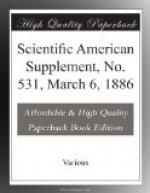Fifth. Freedom of the right hand of the pupil to make instantaneous reproduction in writing of the matter being received through the sense of feeling, thereby opening the way for a valuable class exercise.
Sixth. The possible mental stimulus that accompanies the mastery of a new language, and the consequent ability to receive known ideas through a new medium.
Seventh. A fresh variety of class exercises made possible.
The writer firmly believes in the good that exists in all methods that are, or are to be; in the interdependence rather than the independence of all methods; and in all school-room appliances tending to supplement or expedite the labors of the teacher, whether they are made of materials delved from the earth or snatched from the clouds.
S. TEFFT WALKER,
Superintendent of the Kansas Institution, Olathe, Kans.
* * * * *
WATER GAS.
THE RELATIVE VALUE OF WATER GAS AND OTHER GASES AS IRON REDUCING AGENTS.
By B.H. THWAITE.
In order to approximately ascertain the relative reducing action of water gas, carbon monoxide, and superheated steam on iron ore, the author decided to have carried out the following experiments, which were conducted by Mr. Carl J. Sandahl, of Stockholm, who also carried out the analyses. The ore used was from Bilbao, and known as the Ruby Mine, and was a good average hematite. The carbonaceous material was the Trimsaran South Wales anthracite, and contained about 90 per cent. of carbon.
A small experimental furnace was constructed of the form shown by illustration, about 4 ft. 6 in. high and 2 ft. 3 in. wide at the base, and gradually swelling to 2 ft. 9 in. at the top, built entirely of fireclay bricks. Two refractory tubes, 2 in. square internally, and the height of the furnace, were used for the double purpose of producing the gas and reducing the ore.
The end of the lower tube rested on a fireclay ladle nozzle, and was properly jointed with fireclay; through this nozzle the steam or air was supplied to the inside of the refractory tubes. In each experiment the ore and fuel were raised to the temperature “of from 1,800 to 2,200 deg. Fahr.” by means of an external fire of anthracite. Great care was taken to prevent the contact of the solid carbonaceous fuel with the ore. In each experiment in which steam was used, the latter was supplied at a temperature equivalent to 35 lb. to the square inch.
The air for producing the carbon monoxide (CO) gas was used at the temperature of the atmosphere. As near as possible, the same conditions were obtained in each experiment, and the equivalent weight of air was sent through the carbon to generate the same weight of CO as that generated when steam was used for the production of water gas.
[Illustration]
First Experiment, Steam (per se).—Both tubes, A and B, were filled with ore broken to the size of nuts. The tube, A, was heated to about 2,000 deg. Fahr., the upper one to about 1,500 deg.




